International Marketing Research Report: Loyalty Cards and Business
VerifiedAdded on 2023/01/17
|15
|3834
|86
Report
AI Summary
This report examines the impact of loyalty cards on international marketing strategies. It investigates how loyalty programs influence customer behavior, brand image, and sales revenue. The research explores the benefits of loyalty cards in attracting new clients, fostering customer loyalty, and gaining a competitive advantage in the global marketplace. The report delves into the use of loyalty cards by businesses, analyzing the impact on customer relationships and the role of data in understanding consumer behavior. Key literature is reviewed, including the use of big data and cloud-based technologies, and the impact of loyalty cards on brand image and sales. The report also discusses the importance of customer relationship management and the creation of strong customer bonds. The findings suggest that the use of loyalty cards is a valuable marketing tool that helps businesses respond to customers quickly, increase sales revenue, and expand their customer base in international markets. This report is a valuable resource for students and professionals seeking to understand the role of loyalty cards in international marketing.
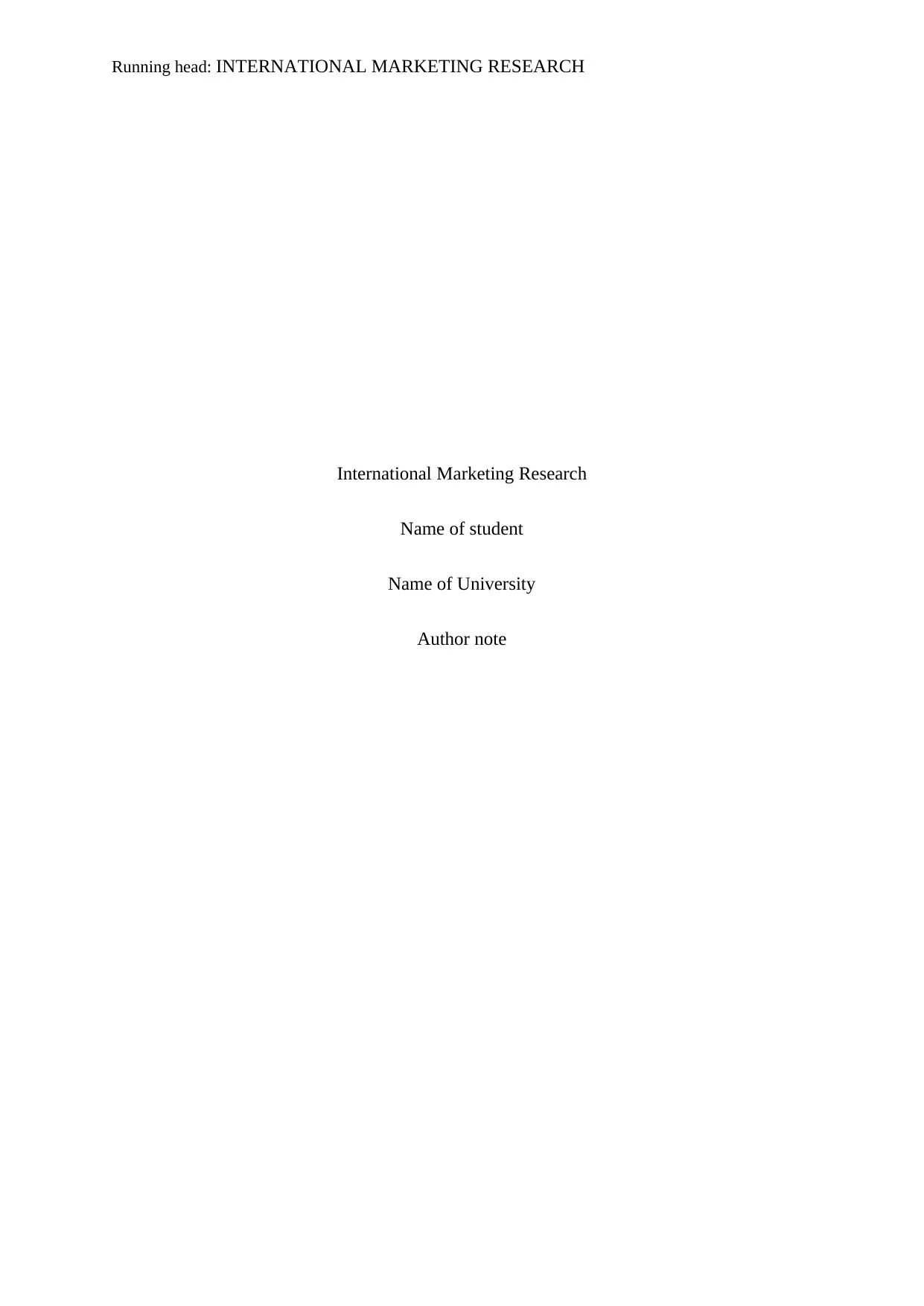
Running head: INTERNATIONAL MARKETING RESEARCH
International Marketing Research
Name of student
Name of University
Author note
International Marketing Research
Name of student
Name of University
Author note
Paraphrase This Document
Need a fresh take? Get an instant paraphrase of this document with our AI Paraphraser
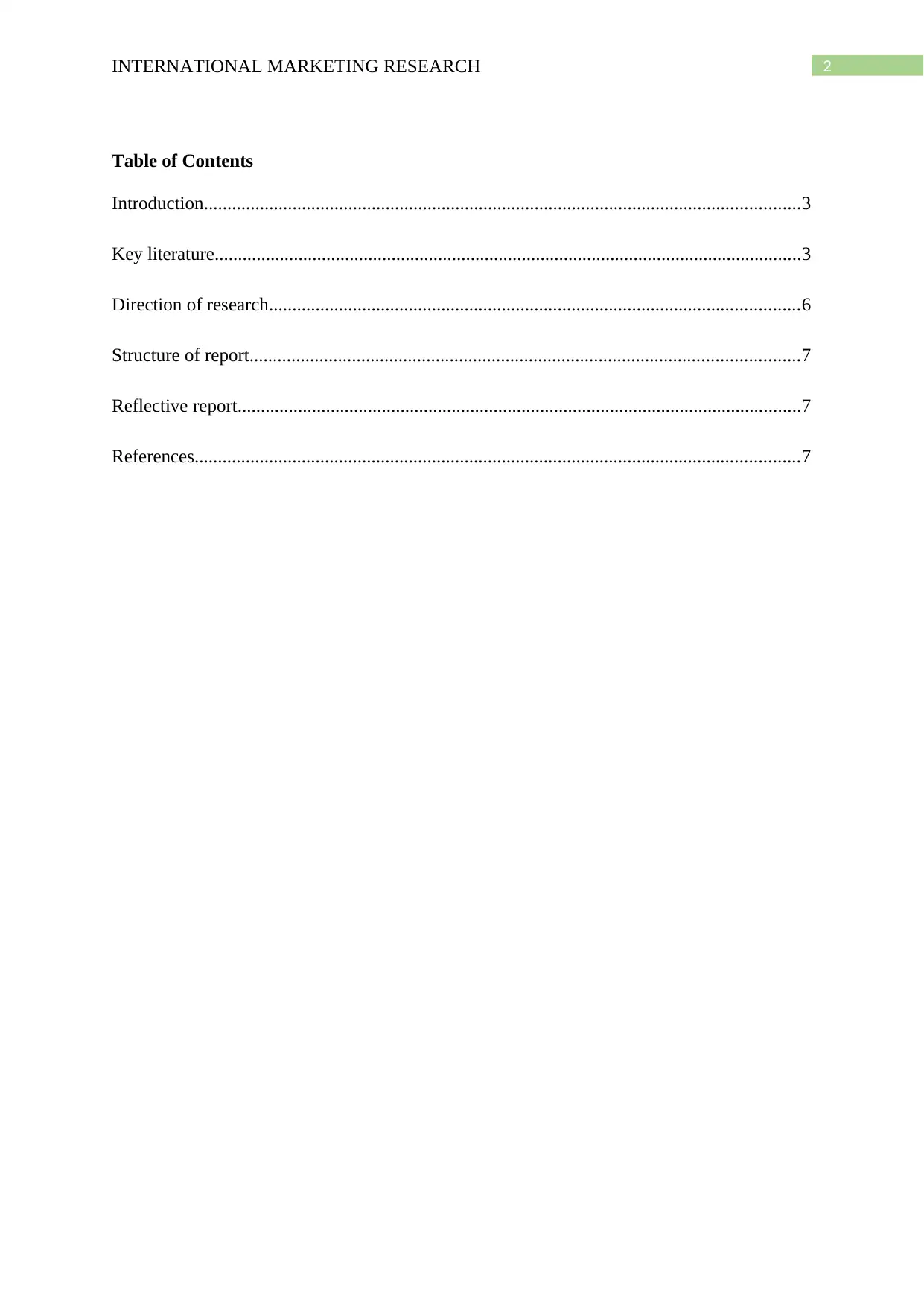
2INTERNATIONAL MARKETING RESEARCH
Table of Contents
Introduction................................................................................................................................3
Key literature..............................................................................................................................3
Direction of research..................................................................................................................6
Structure of report......................................................................................................................7
Reflective report.........................................................................................................................7
References..................................................................................................................................7
Table of Contents
Introduction................................................................................................................................3
Key literature..............................................................................................................................3
Direction of research..................................................................................................................6
Structure of report......................................................................................................................7
Reflective report.........................................................................................................................7
References..................................................................................................................................7
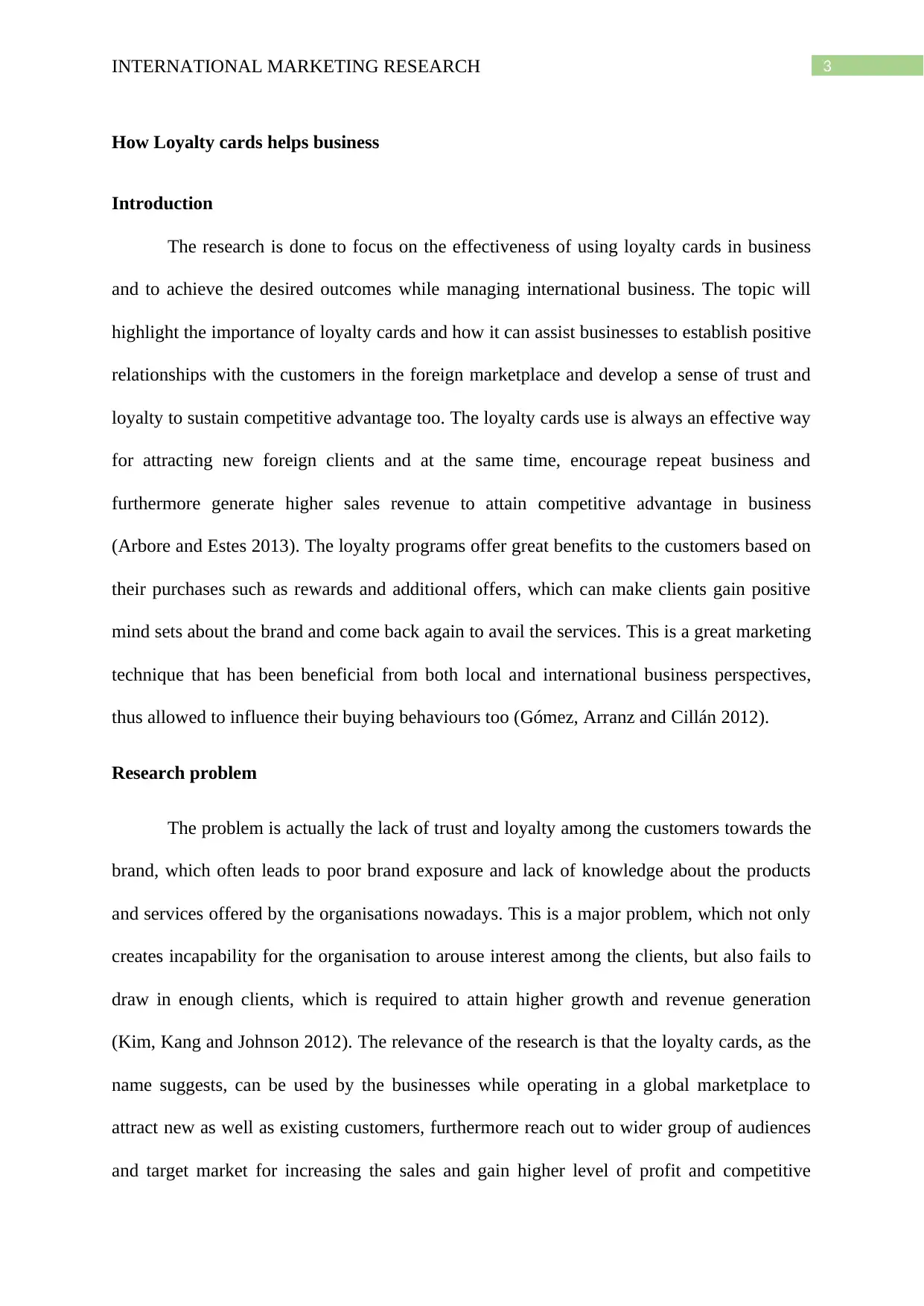
3INTERNATIONAL MARKETING RESEARCH
How Loyalty cards helps business
Introduction
The research is done to focus on the effectiveness of using loyalty cards in business
and to achieve the desired outcomes while managing international business. The topic will
highlight the importance of loyalty cards and how it can assist businesses to establish positive
relationships with the customers in the foreign marketplace and develop a sense of trust and
loyalty to sustain competitive advantage too. The loyalty cards use is always an effective way
for attracting new foreign clients and at the same time, encourage repeat business and
furthermore generate higher sales revenue to attain competitive advantage in business
(Arbore and Estes 2013). The loyalty programs offer great benefits to the customers based on
their purchases such as rewards and additional offers, which can make clients gain positive
mind sets about the brand and come back again to avail the services. This is a great marketing
technique that has been beneficial from both local and international business perspectives,
thus allowed to influence their buying behaviours too (Gómez, Arranz and Cillán 2012).
Research problem
The problem is actually the lack of trust and loyalty among the customers towards the
brand, which often leads to poor brand exposure and lack of knowledge about the products
and services offered by the organisations nowadays. This is a major problem, which not only
creates incapability for the organisation to arouse interest among the clients, but also fails to
draw in enough clients, which is required to attain higher growth and revenue generation
(Kim, Kang and Johnson 2012). The relevance of the research is that the loyalty cards, as the
name suggests, can be used by the businesses while operating in a global marketplace to
attract new as well as existing customers, furthermore reach out to wider group of audiences
and target market for increasing the sales and gain higher level of profit and competitive
How Loyalty cards helps business
Introduction
The research is done to focus on the effectiveness of using loyalty cards in business
and to achieve the desired outcomes while managing international business. The topic will
highlight the importance of loyalty cards and how it can assist businesses to establish positive
relationships with the customers in the foreign marketplace and develop a sense of trust and
loyalty to sustain competitive advantage too. The loyalty cards use is always an effective way
for attracting new foreign clients and at the same time, encourage repeat business and
furthermore generate higher sales revenue to attain competitive advantage in business
(Arbore and Estes 2013). The loyalty programs offer great benefits to the customers based on
their purchases such as rewards and additional offers, which can make clients gain positive
mind sets about the brand and come back again to avail the services. This is a great marketing
technique that has been beneficial from both local and international business perspectives,
thus allowed to influence their buying behaviours too (Gómez, Arranz and Cillán 2012).
Research problem
The problem is actually the lack of trust and loyalty among the customers towards the
brand, which often leads to poor brand exposure and lack of knowledge about the products
and services offered by the organisations nowadays. This is a major problem, which not only
creates incapability for the organisation to arouse interest among the clients, but also fails to
draw in enough clients, which is required to attain higher growth and revenue generation
(Kim, Kang and Johnson 2012). The relevance of the research is that the loyalty cards, as the
name suggests, can be used by the businesses while operating in a global marketplace to
attract new as well as existing customers, furthermore reach out to wider group of audiences
and target market for increasing the sales and gain higher level of profit and competitive
⊘ This is a preview!⊘
Do you want full access?
Subscribe today to unlock all pages.

Trusted by 1+ million students worldwide
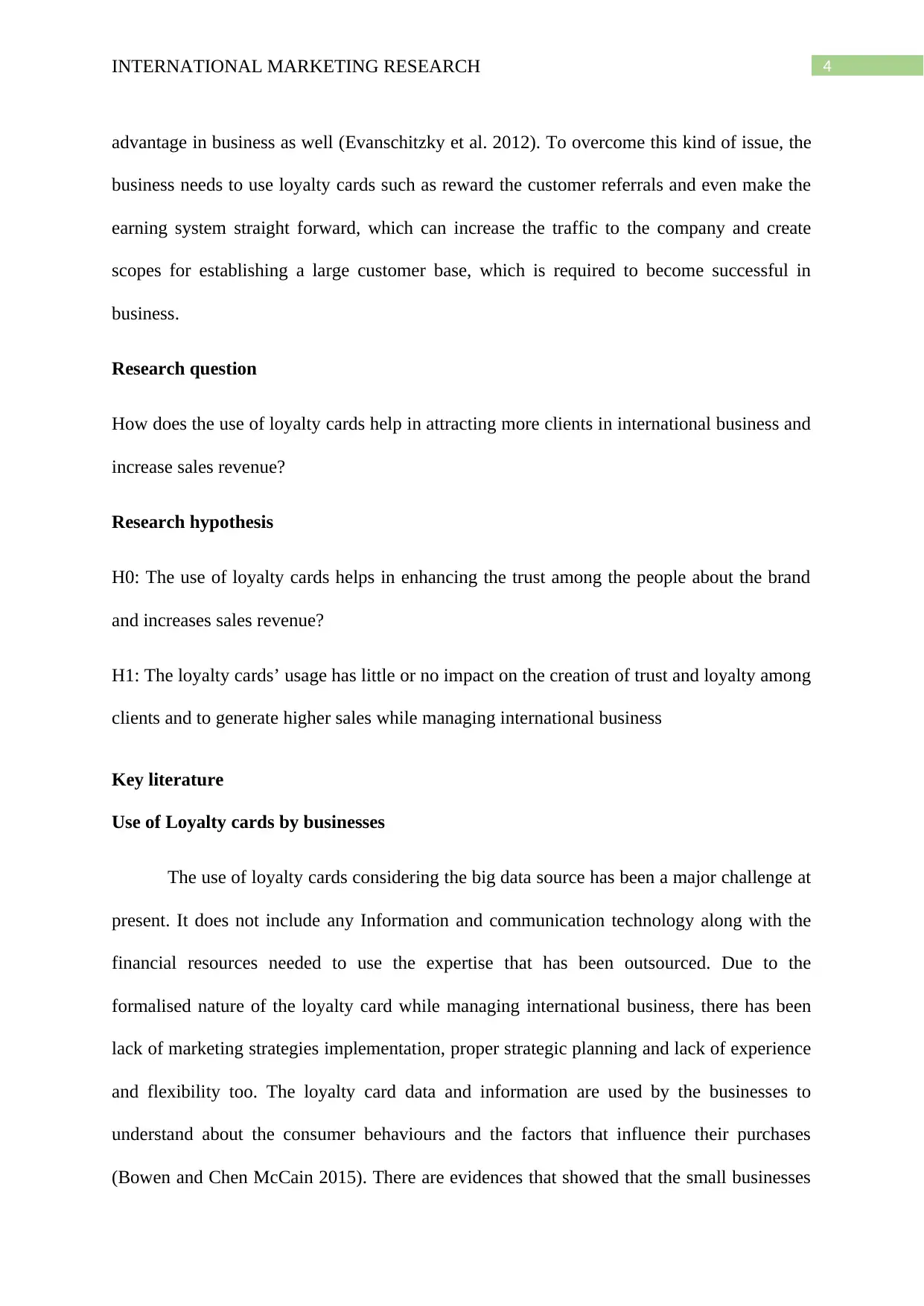
4INTERNATIONAL MARKETING RESEARCH
advantage in business as well (Evanschitzky et al. 2012). To overcome this kind of issue, the
business needs to use loyalty cards such as reward the customer referrals and even make the
earning system straight forward, which can increase the traffic to the company and create
scopes for establishing a large customer base, which is required to become successful in
business.
Research question
How does the use of loyalty cards help in attracting more clients in international business and
increase sales revenue?
Research hypothesis
H0: The use of loyalty cards helps in enhancing the trust among the people about the brand
and increases sales revenue?
H1: The loyalty cards’ usage has little or no impact on the creation of trust and loyalty among
clients and to generate higher sales while managing international business
Key literature
Use of Loyalty cards by businesses
The use of loyalty cards considering the big data source has been a major challenge at
present. It does not include any Information and communication technology along with the
financial resources needed to use the expertise that has been outsourced. Due to the
formalised nature of the loyalty card while managing international business, there has been
lack of marketing strategies implementation, proper strategic planning and lack of experience
and flexibility too. The loyalty card data and information are used by the businesses to
understand about the consumer behaviours and the factors that influence their purchases
(Bowen and Chen McCain 2015). There are evidences that showed that the small businesses
advantage in business as well (Evanschitzky et al. 2012). To overcome this kind of issue, the
business needs to use loyalty cards such as reward the customer referrals and even make the
earning system straight forward, which can increase the traffic to the company and create
scopes for establishing a large customer base, which is required to become successful in
business.
Research question
How does the use of loyalty cards help in attracting more clients in international business and
increase sales revenue?
Research hypothesis
H0: The use of loyalty cards helps in enhancing the trust among the people about the brand
and increases sales revenue?
H1: The loyalty cards’ usage has little or no impact on the creation of trust and loyalty among
clients and to generate higher sales while managing international business
Key literature
Use of Loyalty cards by businesses
The use of loyalty cards considering the big data source has been a major challenge at
present. It does not include any Information and communication technology along with the
financial resources needed to use the expertise that has been outsourced. Due to the
formalised nature of the loyalty card while managing international business, there has been
lack of marketing strategies implementation, proper strategic planning and lack of experience
and flexibility too. The loyalty card data and information are used by the businesses to
understand about the consumer behaviours and the factors that influence their purchases
(Bowen and Chen McCain 2015). There are evidences that showed that the small businesses
Paraphrase This Document
Need a fresh take? Get an instant paraphrase of this document with our AI Paraphraser
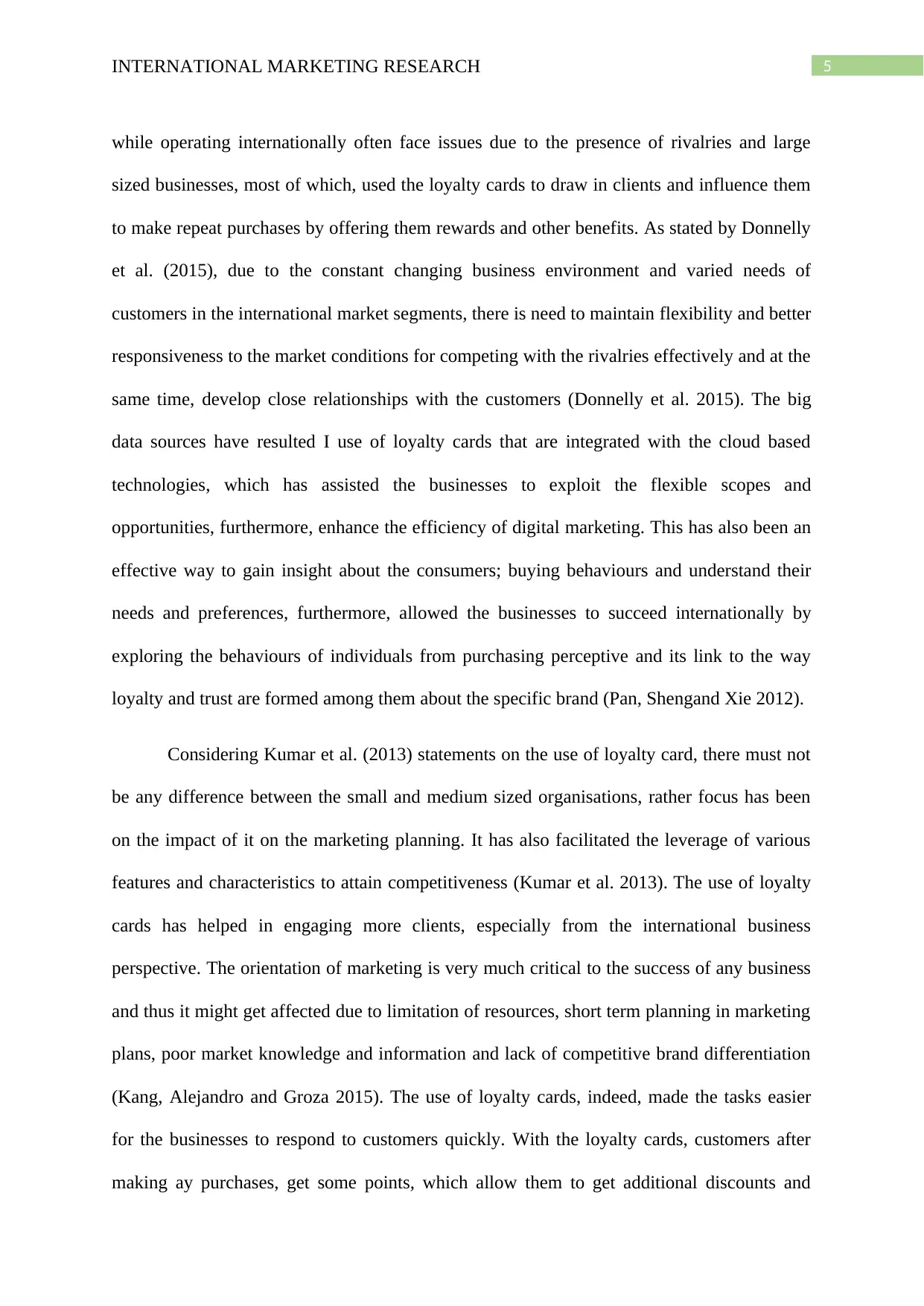
5INTERNATIONAL MARKETING RESEARCH
while operating internationally often face issues due to the presence of rivalries and large
sized businesses, most of which, used the loyalty cards to draw in clients and influence them
to make repeat purchases by offering them rewards and other benefits. As stated by Donnelly
et al. (2015), due to the constant changing business environment and varied needs of
customers in the international market segments, there is need to maintain flexibility and better
responsiveness to the market conditions for competing with the rivalries effectively and at the
same time, develop close relationships with the customers (Donnelly et al. 2015). The big
data sources have resulted I use of loyalty cards that are integrated with the cloud based
technologies, which has assisted the businesses to exploit the flexible scopes and
opportunities, furthermore, enhance the efficiency of digital marketing. This has also been an
effective way to gain insight about the consumers; buying behaviours and understand their
needs and preferences, furthermore, allowed the businesses to succeed internationally by
exploring the behaviours of individuals from purchasing perceptive and its link to the way
loyalty and trust are formed among them about the specific brand (Pan, Shengand Xie 2012).
Considering Kumar et al. (2013) statements on the use of loyalty card, there must not
be any difference between the small and medium sized organisations, rather focus has been
on the impact of it on the marketing planning. It has also facilitated the leverage of various
features and characteristics to attain competitiveness (Kumar et al. 2013). The use of loyalty
cards has helped in engaging more clients, especially from the international business
perspective. The orientation of marketing is very much critical to the success of any business
and thus it might get affected due to limitation of resources, short term planning in marketing
plans, poor market knowledge and information and lack of competitive brand differentiation
(Kang, Alejandro and Groza 2015). The use of loyalty cards, indeed, made the tasks easier
for the businesses to respond to customers quickly. With the loyalty cards, customers after
making ay purchases, get some points, which allow them to get additional discounts and
while operating internationally often face issues due to the presence of rivalries and large
sized businesses, most of which, used the loyalty cards to draw in clients and influence them
to make repeat purchases by offering them rewards and other benefits. As stated by Donnelly
et al. (2015), due to the constant changing business environment and varied needs of
customers in the international market segments, there is need to maintain flexibility and better
responsiveness to the market conditions for competing with the rivalries effectively and at the
same time, develop close relationships with the customers (Donnelly et al. 2015). The big
data sources have resulted I use of loyalty cards that are integrated with the cloud based
technologies, which has assisted the businesses to exploit the flexible scopes and
opportunities, furthermore, enhance the efficiency of digital marketing. This has also been an
effective way to gain insight about the consumers; buying behaviours and understand their
needs and preferences, furthermore, allowed the businesses to succeed internationally by
exploring the behaviours of individuals from purchasing perceptive and its link to the way
loyalty and trust are formed among them about the specific brand (Pan, Shengand Xie 2012).
Considering Kumar et al. (2013) statements on the use of loyalty card, there must not
be any difference between the small and medium sized organisations, rather focus has been
on the impact of it on the marketing planning. It has also facilitated the leverage of various
features and characteristics to attain competitiveness (Kumar et al. 2013). The use of loyalty
cards has helped in engaging more clients, especially from the international business
perspective. The orientation of marketing is very much critical to the success of any business
and thus it might get affected due to limitation of resources, short term planning in marketing
plans, poor market knowledge and information and lack of competitive brand differentiation
(Kang, Alejandro and Groza 2015). The use of loyalty cards, indeed, made the tasks easier
for the businesses to respond to customers quickly. With the loyalty cards, customers after
making ay purchases, get some points, which allow them to get additional discounts and
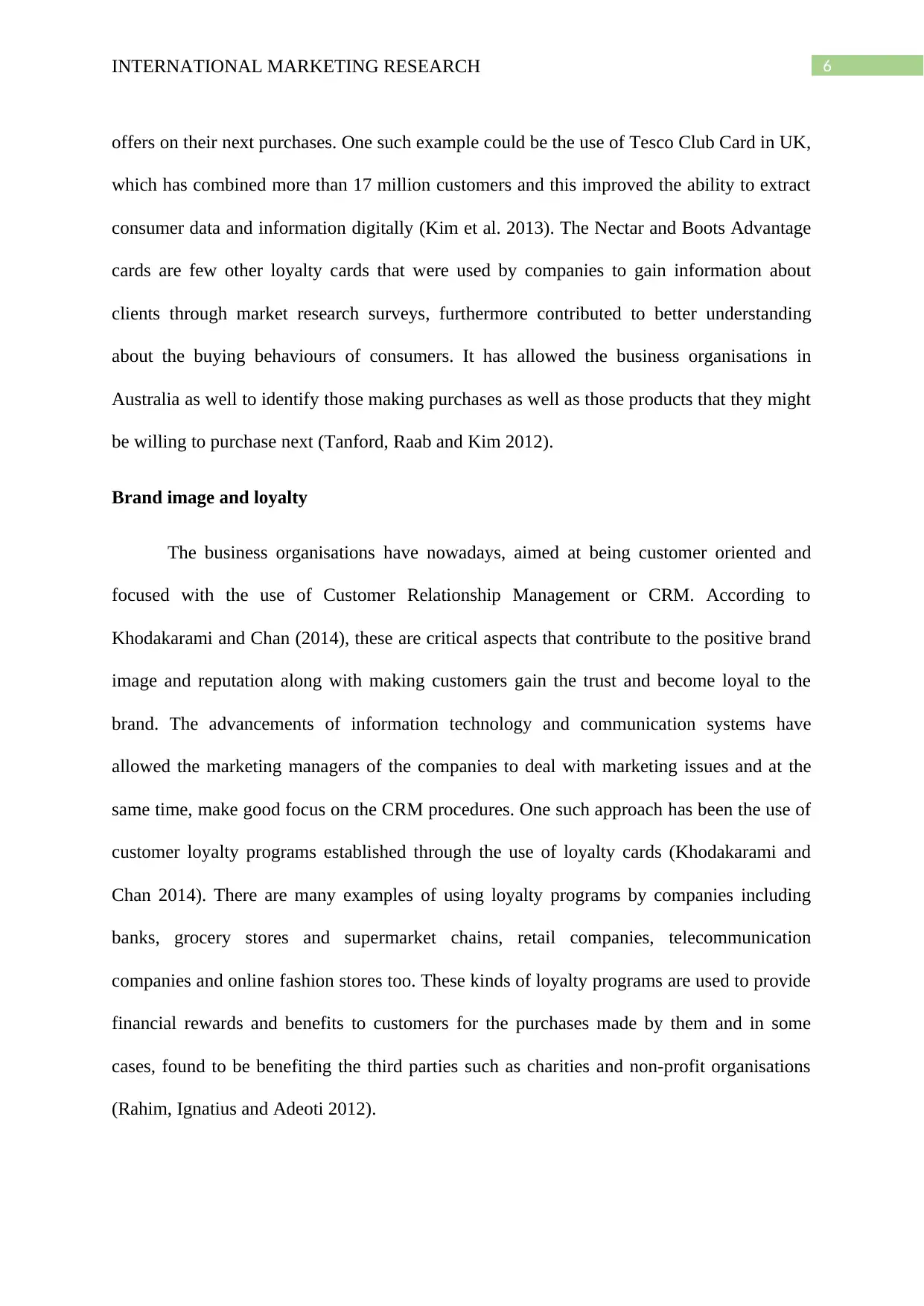
6INTERNATIONAL MARKETING RESEARCH
offers on their next purchases. One such example could be the use of Tesco Club Card in UK,
which has combined more than 17 million customers and this improved the ability to extract
consumer data and information digitally (Kim et al. 2013). The Nectar and Boots Advantage
cards are few other loyalty cards that were used by companies to gain information about
clients through market research surveys, furthermore contributed to better understanding
about the buying behaviours of consumers. It has allowed the business organisations in
Australia as well to identify those making purchases as well as those products that they might
be willing to purchase next (Tanford, Raab and Kim 2012).
Brand image and loyalty
The business organisations have nowadays, aimed at being customer oriented and
focused with the use of Customer Relationship Management or CRM. According to
Khodakarami and Chan (2014), these are critical aspects that contribute to the positive brand
image and reputation along with making customers gain the trust and become loyal to the
brand. The advancements of information technology and communication systems have
allowed the marketing managers of the companies to deal with marketing issues and at the
same time, make good focus on the CRM procedures. One such approach has been the use of
customer loyalty programs established through the use of loyalty cards (Khodakarami and
Chan 2014). There are many examples of using loyalty programs by companies including
banks, grocery stores and supermarket chains, retail companies, telecommunication
companies and online fashion stores too. These kinds of loyalty programs are used to provide
financial rewards and benefits to customers for the purchases made by them and in some
cases, found to be benefiting the third parties such as charities and non-profit organisations
(Rahim, Ignatius and Adeoti 2012).
offers on their next purchases. One such example could be the use of Tesco Club Card in UK,
which has combined more than 17 million customers and this improved the ability to extract
consumer data and information digitally (Kim et al. 2013). The Nectar and Boots Advantage
cards are few other loyalty cards that were used by companies to gain information about
clients through market research surveys, furthermore contributed to better understanding
about the buying behaviours of consumers. It has allowed the business organisations in
Australia as well to identify those making purchases as well as those products that they might
be willing to purchase next (Tanford, Raab and Kim 2012).
Brand image and loyalty
The business organisations have nowadays, aimed at being customer oriented and
focused with the use of Customer Relationship Management or CRM. According to
Khodakarami and Chan (2014), these are critical aspects that contribute to the positive brand
image and reputation along with making customers gain the trust and become loyal to the
brand. The advancements of information technology and communication systems have
allowed the marketing managers of the companies to deal with marketing issues and at the
same time, make good focus on the CRM procedures. One such approach has been the use of
customer loyalty programs established through the use of loyalty cards (Khodakarami and
Chan 2014). There are many examples of using loyalty programs by companies including
banks, grocery stores and supermarket chains, retail companies, telecommunication
companies and online fashion stores too. These kinds of loyalty programs are used to provide
financial rewards and benefits to customers for the purchases made by them and in some
cases, found to be benefiting the third parties such as charities and non-profit organisations
(Rahim, Ignatius and Adeoti 2012).
⊘ This is a preview!⊘
Do you want full access?
Subscribe today to unlock all pages.

Trusted by 1+ million students worldwide
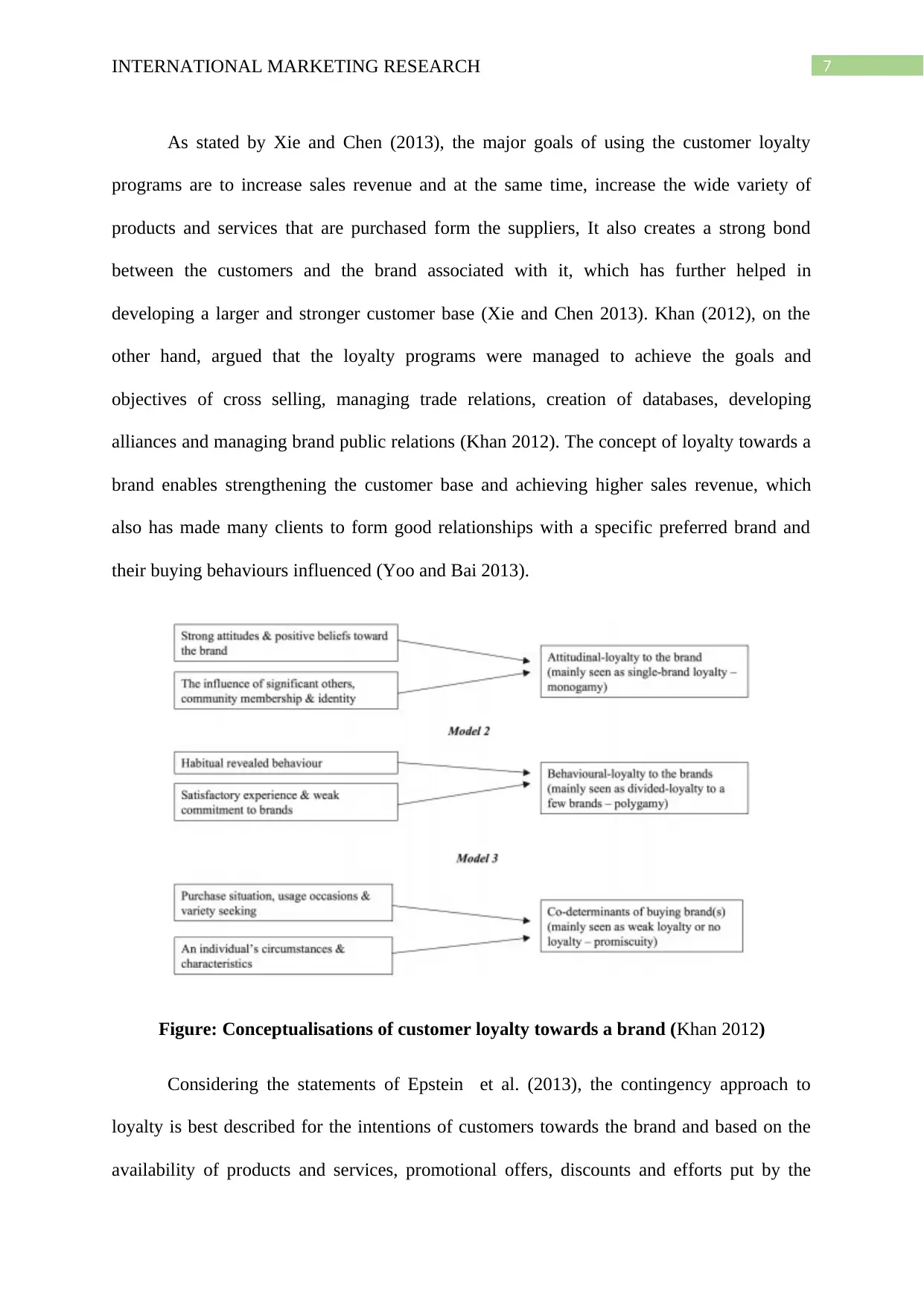
7INTERNATIONAL MARKETING RESEARCH
As stated by Xie and Chen (2013), the major goals of using the customer loyalty
programs are to increase sales revenue and at the same time, increase the wide variety of
products and services that are purchased form the suppliers, It also creates a strong bond
between the customers and the brand associated with it, which has further helped in
developing a larger and stronger customer base (Xie and Chen 2013). Khan (2012), on the
other hand, argued that the loyalty programs were managed to achieve the goals and
objectives of cross selling, managing trade relations, creation of databases, developing
alliances and managing brand public relations (Khan 2012). The concept of loyalty towards a
brand enables strengthening the customer base and achieving higher sales revenue, which
also has made many clients to form good relationships with a specific preferred brand and
their buying behaviours influenced (Yoo and Bai 2013).
Figure: Conceptualisations of customer loyalty towards a brand (Khan 2012)
Considering the statements of Epstein et al. (2013), the contingency approach to
loyalty is best described for the intentions of customers towards the brand and based on the
availability of products and services, promotional offers, discounts and efforts put by the
As stated by Xie and Chen (2013), the major goals of using the customer loyalty
programs are to increase sales revenue and at the same time, increase the wide variety of
products and services that are purchased form the suppliers, It also creates a strong bond
between the customers and the brand associated with it, which has further helped in
developing a larger and stronger customer base (Xie and Chen 2013). Khan (2012), on the
other hand, argued that the loyalty programs were managed to achieve the goals and
objectives of cross selling, managing trade relations, creation of databases, developing
alliances and managing brand public relations (Khan 2012). The concept of loyalty towards a
brand enables strengthening the customer base and achieving higher sales revenue, which
also has made many clients to form good relationships with a specific preferred brand and
their buying behaviours influenced (Yoo and Bai 2013).
Figure: Conceptualisations of customer loyalty towards a brand (Khan 2012)
Considering the statements of Epstein et al. (2013), the contingency approach to
loyalty is best described for the intentions of customers towards the brand and based on the
availability of products and services, promotional offers, discounts and efforts put by the
Paraphrase This Document
Need a fresh take? Get an instant paraphrase of this document with our AI Paraphraser
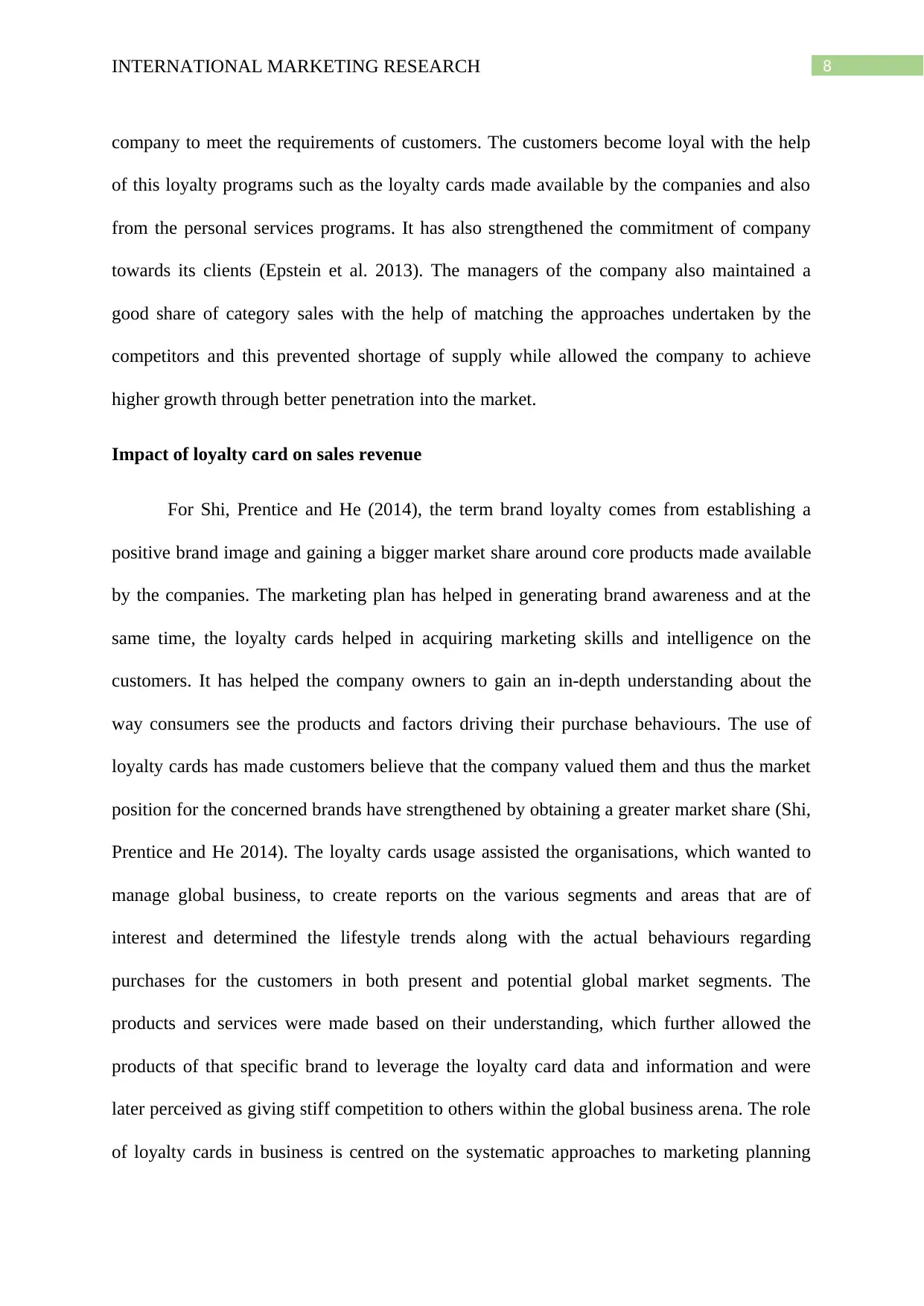
8INTERNATIONAL MARKETING RESEARCH
company to meet the requirements of customers. The customers become loyal with the help
of this loyalty programs such as the loyalty cards made available by the companies and also
from the personal services programs. It has also strengthened the commitment of company
towards its clients (Epstein et al. 2013). The managers of the company also maintained a
good share of category sales with the help of matching the approaches undertaken by the
competitors and this prevented shortage of supply while allowed the company to achieve
higher growth through better penetration into the market.
Impact of loyalty card on sales revenue
For Shi, Prentice and He (2014), the term brand loyalty comes from establishing a
positive brand image and gaining a bigger market share around core products made available
by the companies. The marketing plan has helped in generating brand awareness and at the
same time, the loyalty cards helped in acquiring marketing skills and intelligence on the
customers. It has helped the company owners to gain an in-depth understanding about the
way consumers see the products and factors driving their purchase behaviours. The use of
loyalty cards has made customers believe that the company valued them and thus the market
position for the concerned brands have strengthened by obtaining a greater market share (Shi,
Prentice and He 2014). The loyalty cards usage assisted the organisations, which wanted to
manage global business, to create reports on the various segments and areas that are of
interest and determined the lifestyle trends along with the actual behaviours regarding
purchases for the customers in both present and potential global market segments. The
products and services were made based on their understanding, which further allowed the
products of that specific brand to leverage the loyalty card data and information and were
later perceived as giving stiff competition to others within the global business arena. The role
of loyalty cards in business is centred on the systematic approaches to marketing planning
company to meet the requirements of customers. The customers become loyal with the help
of this loyalty programs such as the loyalty cards made available by the companies and also
from the personal services programs. It has also strengthened the commitment of company
towards its clients (Epstein et al. 2013). The managers of the company also maintained a
good share of category sales with the help of matching the approaches undertaken by the
competitors and this prevented shortage of supply while allowed the company to achieve
higher growth through better penetration into the market.
Impact of loyalty card on sales revenue
For Shi, Prentice and He (2014), the term brand loyalty comes from establishing a
positive brand image and gaining a bigger market share around core products made available
by the companies. The marketing plan has helped in generating brand awareness and at the
same time, the loyalty cards helped in acquiring marketing skills and intelligence on the
customers. It has helped the company owners to gain an in-depth understanding about the
way consumers see the products and factors driving their purchase behaviours. The use of
loyalty cards has made customers believe that the company valued them and thus the market
position for the concerned brands have strengthened by obtaining a greater market share (Shi,
Prentice and He 2014). The loyalty cards usage assisted the organisations, which wanted to
manage global business, to create reports on the various segments and areas that are of
interest and determined the lifestyle trends along with the actual behaviours regarding
purchases for the customers in both present and potential global market segments. The
products and services were made based on their understanding, which further allowed the
products of that specific brand to leverage the loyalty card data and information and were
later perceived as giving stiff competition to others within the global business arena. The role
of loyalty cards in business is centred on the systematic approaches to marketing planning
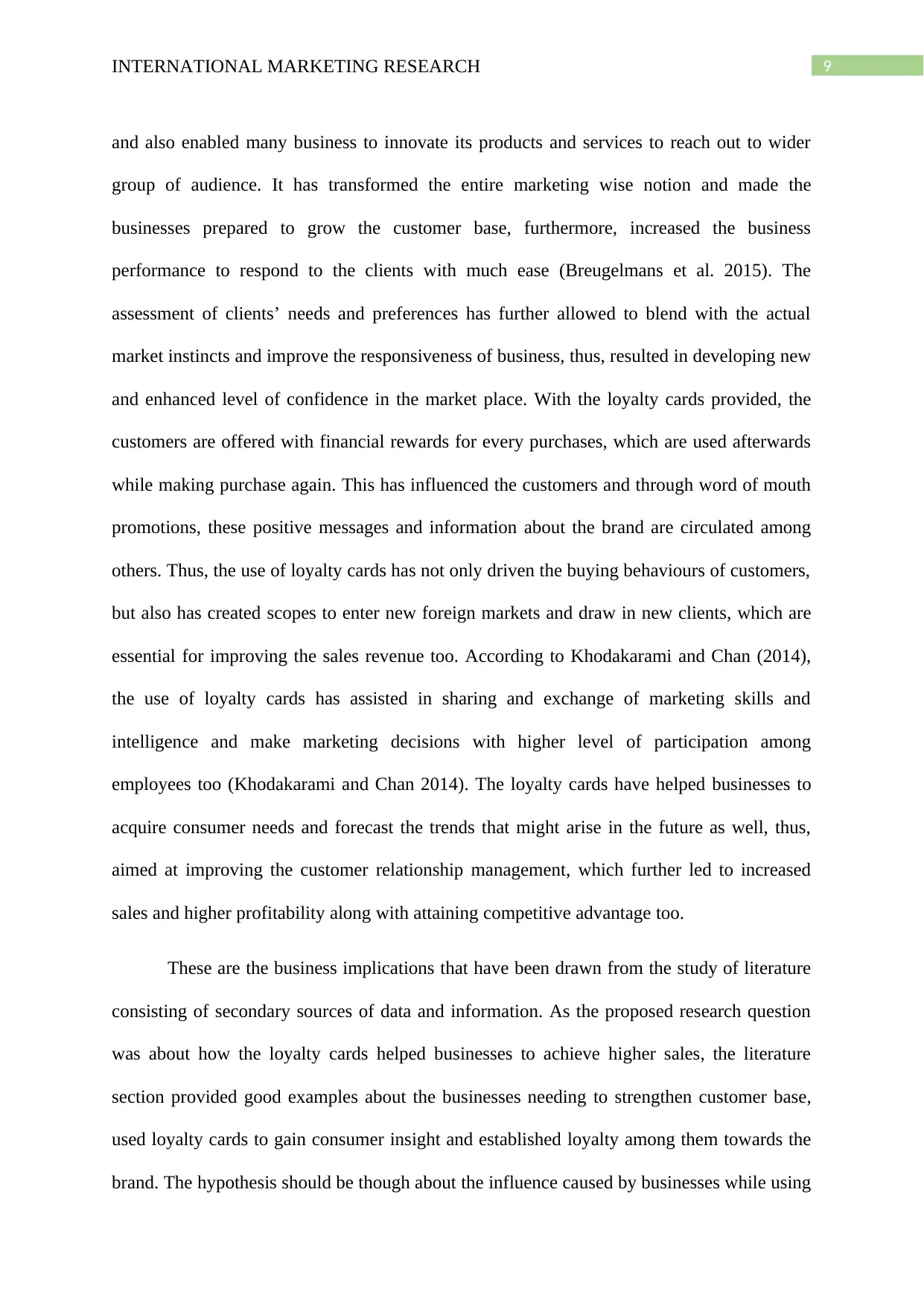
9INTERNATIONAL MARKETING RESEARCH
and also enabled many business to innovate its products and services to reach out to wider
group of audience. It has transformed the entire marketing wise notion and made the
businesses prepared to grow the customer base, furthermore, increased the business
performance to respond to the clients with much ease (Breugelmans et al. 2015). The
assessment of clients’ needs and preferences has further allowed to blend with the actual
market instincts and improve the responsiveness of business, thus, resulted in developing new
and enhanced level of confidence in the market place. With the loyalty cards provided, the
customers are offered with financial rewards for every purchases, which are used afterwards
while making purchase again. This has influenced the customers and through word of mouth
promotions, these positive messages and information about the brand are circulated among
others. Thus, the use of loyalty cards has not only driven the buying behaviours of customers,
but also has created scopes to enter new foreign markets and draw in new clients, which are
essential for improving the sales revenue too. According to Khodakarami and Chan (2014),
the use of loyalty cards has assisted in sharing and exchange of marketing skills and
intelligence and make marketing decisions with higher level of participation among
employees too (Khodakarami and Chan 2014). The loyalty cards have helped businesses to
acquire consumer needs and forecast the trends that might arise in the future as well, thus,
aimed at improving the customer relationship management, which further led to increased
sales and higher profitability along with attaining competitive advantage too.
These are the business implications that have been drawn from the study of literature
consisting of secondary sources of data and information. As the proposed research question
was about how the loyalty cards helped businesses to achieve higher sales, the literature
section provided good examples about the businesses needing to strengthen customer base,
used loyalty cards to gain consumer insight and established loyalty among them towards the
brand. The hypothesis should be though about the influence caused by businesses while using
and also enabled many business to innovate its products and services to reach out to wider
group of audience. It has transformed the entire marketing wise notion and made the
businesses prepared to grow the customer base, furthermore, increased the business
performance to respond to the clients with much ease (Breugelmans et al. 2015). The
assessment of clients’ needs and preferences has further allowed to blend with the actual
market instincts and improve the responsiveness of business, thus, resulted in developing new
and enhanced level of confidence in the market place. With the loyalty cards provided, the
customers are offered with financial rewards for every purchases, which are used afterwards
while making purchase again. This has influenced the customers and through word of mouth
promotions, these positive messages and information about the brand are circulated among
others. Thus, the use of loyalty cards has not only driven the buying behaviours of customers,
but also has created scopes to enter new foreign markets and draw in new clients, which are
essential for improving the sales revenue too. According to Khodakarami and Chan (2014),
the use of loyalty cards has assisted in sharing and exchange of marketing skills and
intelligence and make marketing decisions with higher level of participation among
employees too (Khodakarami and Chan 2014). The loyalty cards have helped businesses to
acquire consumer needs and forecast the trends that might arise in the future as well, thus,
aimed at improving the customer relationship management, which further led to increased
sales and higher profitability along with attaining competitive advantage too.
These are the business implications that have been drawn from the study of literature
consisting of secondary sources of data and information. As the proposed research question
was about how the loyalty cards helped businesses to achieve higher sales, the literature
section provided good examples about the businesses needing to strengthen customer base,
used loyalty cards to gain consumer insight and established loyalty among them towards the
brand. The hypothesis should be though about the influence caused by businesses while using
⊘ This is a preview!⊘
Do you want full access?
Subscribe today to unlock all pages.

Trusted by 1+ million students worldwide
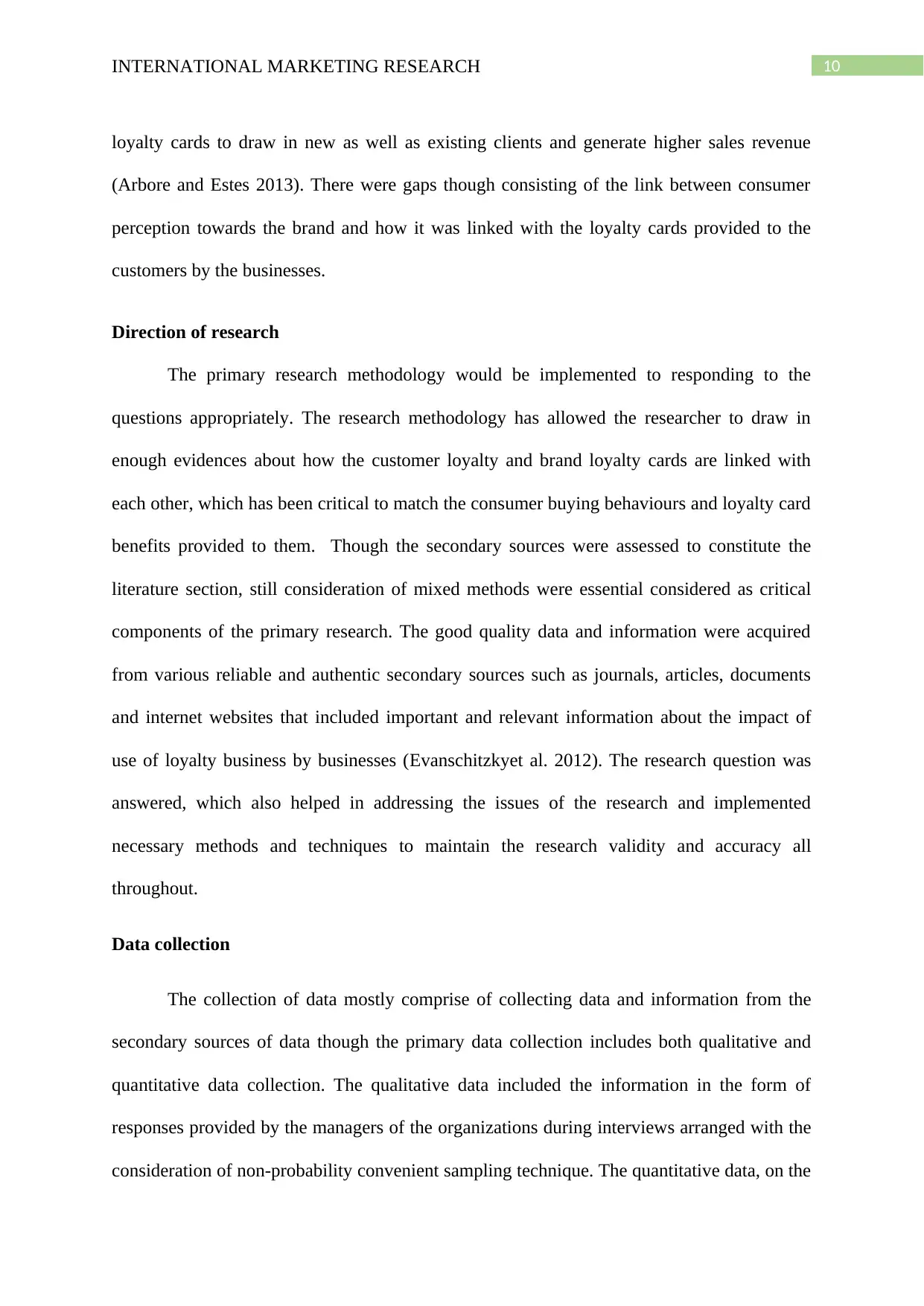
10INTERNATIONAL MARKETING RESEARCH
loyalty cards to draw in new as well as existing clients and generate higher sales revenue
(Arbore and Estes 2013). There were gaps though consisting of the link between consumer
perception towards the brand and how it was linked with the loyalty cards provided to the
customers by the businesses.
Direction of research
The primary research methodology would be implemented to responding to the
questions appropriately. The research methodology has allowed the researcher to draw in
enough evidences about how the customer loyalty and brand loyalty cards are linked with
each other, which has been critical to match the consumer buying behaviours and loyalty card
benefits provided to them. Though the secondary sources were assessed to constitute the
literature section, still consideration of mixed methods were essential considered as critical
components of the primary research. The good quality data and information were acquired
from various reliable and authentic secondary sources such as journals, articles, documents
and internet websites that included important and relevant information about the impact of
use of loyalty business by businesses (Evanschitzkyet al. 2012). The research question was
answered, which also helped in addressing the issues of the research and implemented
necessary methods and techniques to maintain the research validity and accuracy all
throughout.
Data collection
The collection of data mostly comprise of collecting data and information from the
secondary sources of data though the primary data collection includes both qualitative and
quantitative data collection. The qualitative data included the information in the form of
responses provided by the managers of the organizations during interviews arranged with the
consideration of non-probability convenient sampling technique. The quantitative data, on the
loyalty cards to draw in new as well as existing clients and generate higher sales revenue
(Arbore and Estes 2013). There were gaps though consisting of the link between consumer
perception towards the brand and how it was linked with the loyalty cards provided to the
customers by the businesses.
Direction of research
The primary research methodology would be implemented to responding to the
questions appropriately. The research methodology has allowed the researcher to draw in
enough evidences about how the customer loyalty and brand loyalty cards are linked with
each other, which has been critical to match the consumer buying behaviours and loyalty card
benefits provided to them. Though the secondary sources were assessed to constitute the
literature section, still consideration of mixed methods were essential considered as critical
components of the primary research. The good quality data and information were acquired
from various reliable and authentic secondary sources such as journals, articles, documents
and internet websites that included important and relevant information about the impact of
use of loyalty business by businesses (Evanschitzkyet al. 2012). The research question was
answered, which also helped in addressing the issues of the research and implemented
necessary methods and techniques to maintain the research validity and accuracy all
throughout.
Data collection
The collection of data mostly comprise of collecting data and information from the
secondary sources of data though the primary data collection includes both qualitative and
quantitative data collection. The qualitative data included the information in the form of
responses provided by the managers of the organizations during interviews arranged with the
consideration of non-probability convenient sampling technique. The quantitative data, on the
Paraphrase This Document
Need a fresh take? Get an instant paraphrase of this document with our AI Paraphraser
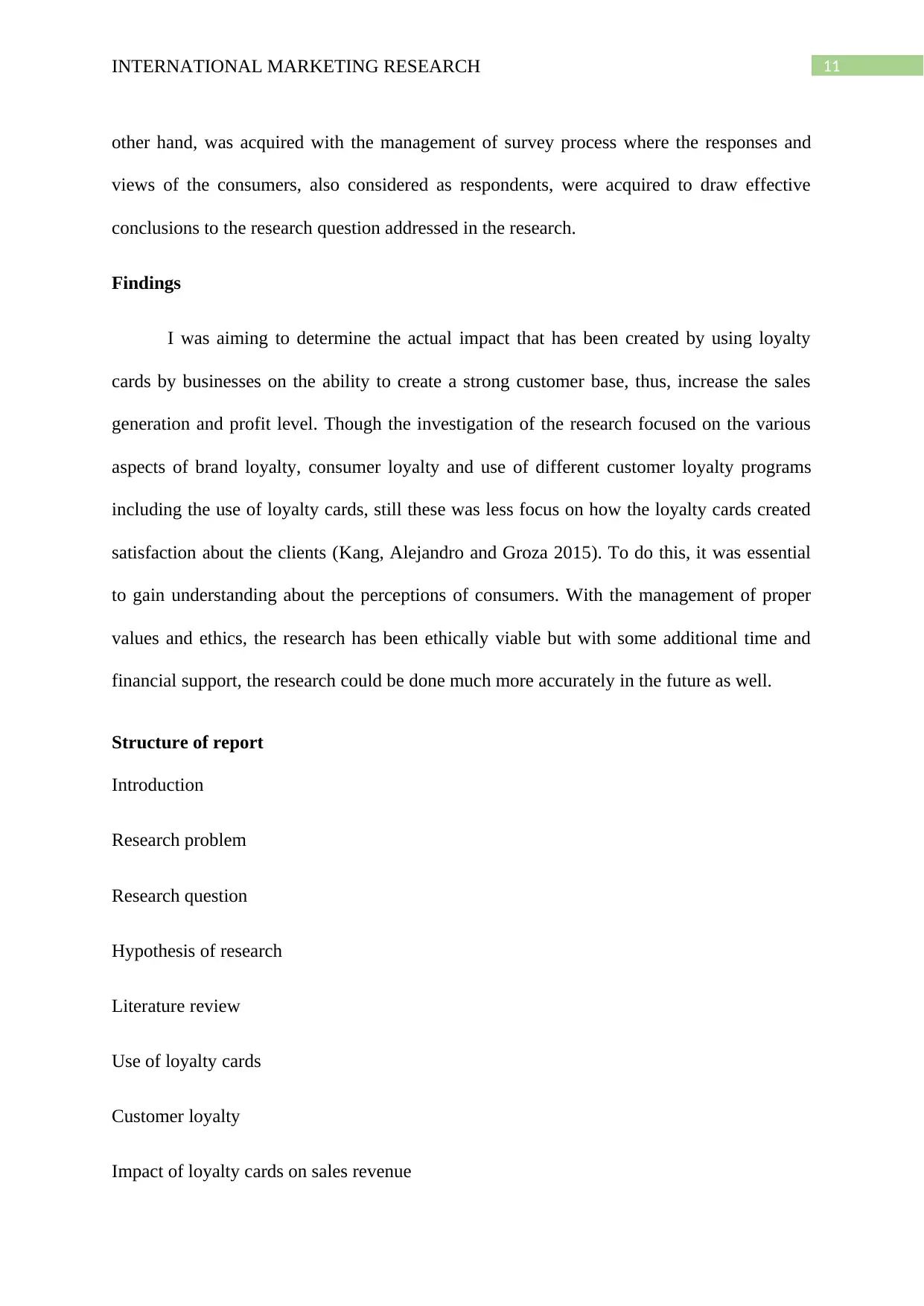
11INTERNATIONAL MARKETING RESEARCH
other hand, was acquired with the management of survey process where the responses and
views of the consumers, also considered as respondents, were acquired to draw effective
conclusions to the research question addressed in the research.
Findings
I was aiming to determine the actual impact that has been created by using loyalty
cards by businesses on the ability to create a strong customer base, thus, increase the sales
generation and profit level. Though the investigation of the research focused on the various
aspects of brand loyalty, consumer loyalty and use of different customer loyalty programs
including the use of loyalty cards, still these was less focus on how the loyalty cards created
satisfaction about the clients (Kang, Alejandro and Groza 2015). To do this, it was essential
to gain understanding about the perceptions of consumers. With the management of proper
values and ethics, the research has been ethically viable but with some additional time and
financial support, the research could be done much more accurately in the future as well.
Structure of report
Introduction
Research problem
Research question
Hypothesis of research
Literature review
Use of loyalty cards
Customer loyalty
Impact of loyalty cards on sales revenue
other hand, was acquired with the management of survey process where the responses and
views of the consumers, also considered as respondents, were acquired to draw effective
conclusions to the research question addressed in the research.
Findings
I was aiming to determine the actual impact that has been created by using loyalty
cards by businesses on the ability to create a strong customer base, thus, increase the sales
generation and profit level. Though the investigation of the research focused on the various
aspects of brand loyalty, consumer loyalty and use of different customer loyalty programs
including the use of loyalty cards, still these was less focus on how the loyalty cards created
satisfaction about the clients (Kang, Alejandro and Groza 2015). To do this, it was essential
to gain understanding about the perceptions of consumers. With the management of proper
values and ethics, the research has been ethically viable but with some additional time and
financial support, the research could be done much more accurately in the future as well.
Structure of report
Introduction
Research problem
Research question
Hypothesis of research
Literature review
Use of loyalty cards
Customer loyalty
Impact of loyalty cards on sales revenue
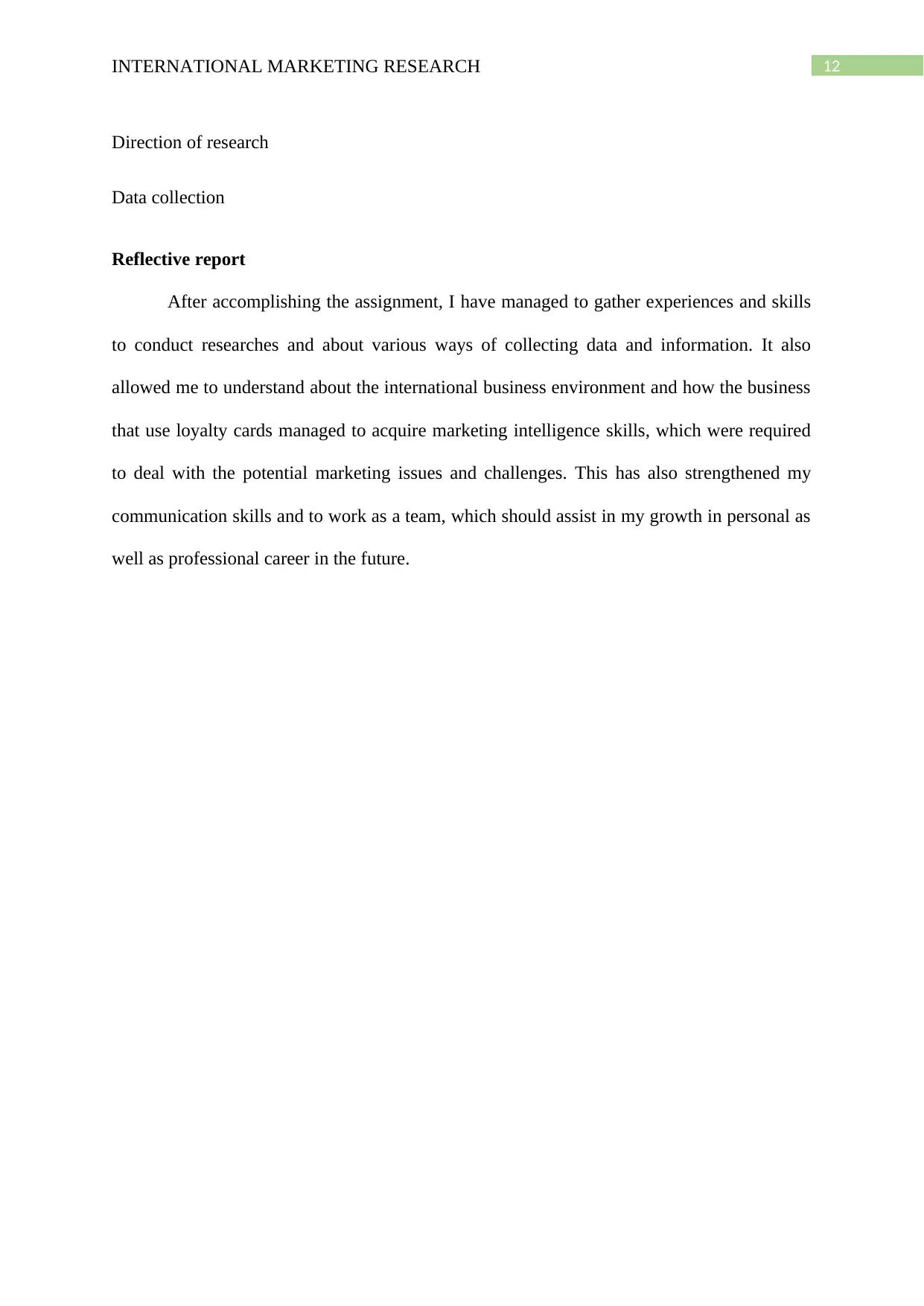
12INTERNATIONAL MARKETING RESEARCH
Direction of research
Data collection
Reflective report
After accomplishing the assignment, I have managed to gather experiences and skills
to conduct researches and about various ways of collecting data and information. It also
allowed me to understand about the international business environment and how the business
that use loyalty cards managed to acquire marketing intelligence skills, which were required
to deal with the potential marketing issues and challenges. This has also strengthened my
communication skills and to work as a team, which should assist in my growth in personal as
well as professional career in the future.
Direction of research
Data collection
Reflective report
After accomplishing the assignment, I have managed to gather experiences and skills
to conduct researches and about various ways of collecting data and information. It also
allowed me to understand about the international business environment and how the business
that use loyalty cards managed to acquire marketing intelligence skills, which were required
to deal with the potential marketing issues and challenges. This has also strengthened my
communication skills and to work as a team, which should assist in my growth in personal as
well as professional career in the future.
⊘ This is a preview!⊘
Do you want full access?
Subscribe today to unlock all pages.

Trusted by 1+ million students worldwide
1 out of 15
Related Documents
Your All-in-One AI-Powered Toolkit for Academic Success.
+13062052269
info@desklib.com
Available 24*7 on WhatsApp / Email
![[object Object]](/_next/static/media/star-bottom.7253800d.svg)
Unlock your academic potential
Copyright © 2020–2025 A2Z Services. All Rights Reserved. Developed and managed by ZUCOL.





